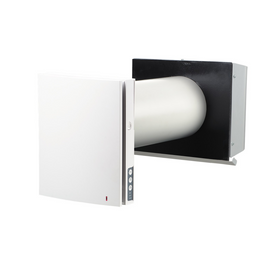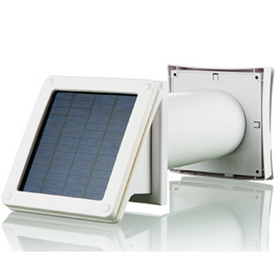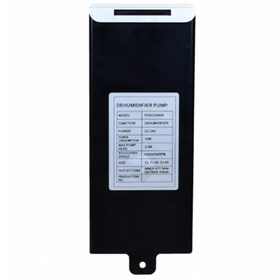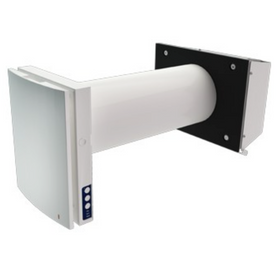
How to Save Your Warm Air with the Air Pear
Last Updated: Apr 9, 2025On a warm summer afternoon, the chances are that homes with high ceilings will find that the air higher up towards the ceiling is significantly warmer than the rest of the house, even if you have the air conditioning turned down to 60 degrees. Hot air rises, and if you have a lofted guest bedroom that doesn’t have a separate HVAC duct, you might find that your guests are continually asking you to turn up the AC. Homes or other buildings with high ceilings and large open spaces often suffer from stratified air impact, which essentially means that the air inside your home is separated or stratified by different temperature levels. The Air Pear, designed by Airius fans, is one unique invention that can help you to get rid of the different temperature levels inside your home or other large buildings on your property.
What is the Air Pear, and How Does it Work?
The Air Pear is an air turbine destratification fan designed for use in buildings with ceilings ranging from 8 to 100 feet in height. From airplane hangars to pharmaceutical warehouses to large barns, the Air Pear has a wide range of uses across different industries.
The venture nozzle design, along with a patented stator system, allows the Air Pear to effectively mix stratified air from the ceiling to the floor, even in the largest of buildings. The energy-efficient motor works to create a laminar, non-turbulent column of air that effectively mixes the air in open spaces to ensure a consistent temperature throughout the building.
While the Air Pear has been marketed to office buildings, industrial warehouses, and other businesses that operate in large, open spaces, this product can also be pre-optimized for any building layout, including individual homes. Unless you live in a shipping container home with a maximum ceiling height of 8 feet, your home probably suffers from some air stratification. Since most tiny homes include lofted sleeping areas to maximize interior living space, the Air Pear is also a great way to circulate air inside a tiny house to maintain a comfortable temperature throughout the different levels.
The layout of each building determines the fan's speed, and the Air Pear can also be configured to operate at variable speeds. When an abundance of warm air is migrating towards the top of your vaulted ceilings during hot summer months, the Air Pear can be operated via wireless controls, smart light switches, or an energy automation platform to work more intensely.
Benefits of the Air Pear
Thermal stratification inside a home is a natural process. Hot air rises, and cold air sinks, so the cooler air produced by your air conditioner will tend to congregate near the floor of your house. Homes with high ceilings have significant temperature differences between different levels, sometimes with up to 20 degrees of difference. During the winter, the opposite occurs where the warmer air produced by your furnace will rise to higher areas of your home while the colder ambient air will settle towards the living area. In many cases, HVAC units can overheat due to the extra effort and energy needed to deal with the thermal stratification.
While an Energy Star ceiling fan is one way to circulate the air inside your home, for homes with high, vaulted ceilings or lofted living areas, ceiling fans might not be enough to mix the interior air effectively. The Air Pear, on the other hand, is specifically designed to continuously and gently mix the air and balance temperatures from the ceiling to the floor inside your home, thus helping your HVAC system maintain the desired temperature. Below, we look at some of the benefits of installing an Air Pear inside a single-family residence.
Improve Indoor Comfort
First and foremost, the Air Pear can help to improve interior comfort. Suppose your home suffers from hot, muggy air in higher areas. In that case, the Air Pear will effectively recirculate and mix the air throughout your home so that you can better control the interior temperature. While a programmable thermostat can help you save on your energy bills, a comfortable 68 degrees on the floor level (where the thermostat is likely to be located) might often mean that your lofted play area is a sweltering 80 degrees.
Save on your HVAC Costs
The Air Pear can also help you save on the cost of heating and cooling your home, which accounts for almost half of all home energy use. According to the company, the Air Pear can lead to a 35 percent reduction in heating costs and a 30 reduction in air conditioning expenses. For example, if your thermostat is located in a high area of your home, the chances are that it has to work harder to keep your home cool during the hot summer. Alternatively, during the wintertime, thermostats located on the ground level will likely perceive cooler temperatures as much of the hot air rises to the higher locations inside the home.
The Air Pear will improve the overall efficiency of HVAC systems while simultaneously reducing the run time of your HVAC equipment. The energy savings associated with this thermal destratification technology allows for a return on investment (ROI) within 12 to 36 months, and that doesn’t even factor into account the expected extended life of your HVAC equipment that comes with less intense use.
The Air Pear can also be used in green homes designed for passive solar heating and cooling as it can circulate and mix the natural solar heat and energy that enters the house.
Reduce Your Carbon Footprint
The Air Pear is also a great strategy to reduce the carbon footprint of your home. The U.S. Department of Energy estimates that the energy used by air conditioning units in the United States accounts for 117 million metric tons of carbon dioxide released into the atmosphere each year. The ecological footprint of heating our homes is similar.
Because the Air Pear efficiently mixes the heated or cooled air inside your home, this reduces the amount of time that your HVAC unit will need to work. Not only will this save you money, but it will also drastically reduce the greenhouse gas emissions associated with your home.
Where to Place Your Air Pear?
There are several different models and sizes of the Air Pear, depending on the highest interior height of ceilings. Units are sized anywhere between 10 feet and 60 feet, and they are also designed specifically for free hanging for suspended ceilings. Each Air Pear unit can generally mix air for anywhere between 1,000 and 2,500 square feet, depending on the home's design.
The Air Pear can help to improve the comfort inside your home while also reducing your energy bills. You can get a free, quick quote for a thermal destratification system explicitly designed for your home by filling out this form.
Table of Contents
Tobias Roberts
Tobias runs an agroecology farm and a natural building collective in the mountains of El Salvador. He specializes in earthen construction methods and uses permaculture design methods to integrate structures into the sustainability of the landscape.










